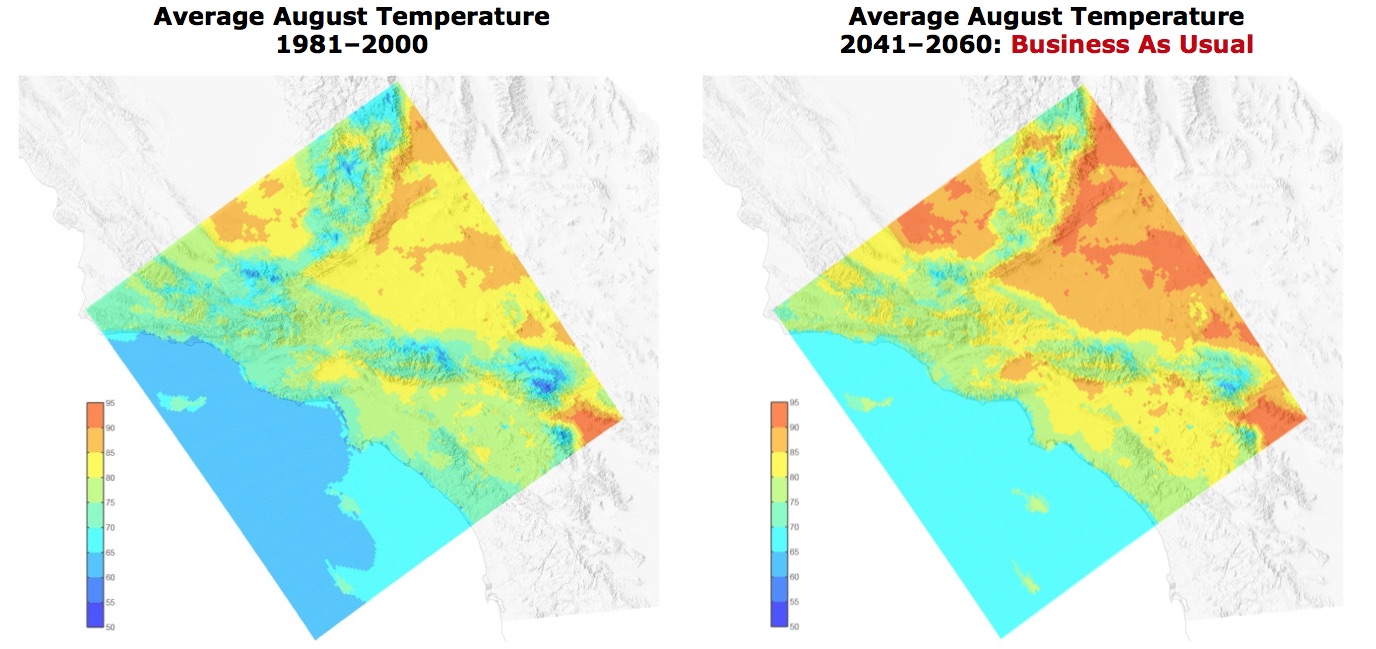
|
||||||||||||||||
|

The Climate Change in the Los Angeles Region Project As the Intergovernmental Panel on Climate Change (IPCC) reaffirmed in its Fifth Assessment Report, global climate is changing in response to human emissions of greenhouse gases. With the help of global climate models (GCMs), computer models that simulate the climate system, scientists are able to project the future state of the climate given different scenarios of greenhouse-gas emissions. While GCMs can tell us a lot about climate change over large regions, they do not provide enough detail to help us understand likely impacts in our own backyards. That's why our team undertook a comprehensive study of climate change in the Los Angeles region, using a new technique to downscale information from multiple GCMs and produce neighborhood-by-neighborhood projections of future climate. This page summarizes the study's findings on likely changes by the middle and end of this century. Study Methods
Temperature Findings
[skip to Precipitation
Findings] At mid-century (2041每2060):

Fig. 1: A spatial representation of average August temperatures in the baseline period (1981每2000, at left) shows that coastal areas tend to be cooler than inland areas separated from the coast by a mountain range. At right, the corresponding image is down for the mid-century (2041每2060) period under the business-as-usual (RCP8.5) scenario of greenhouse gas concentrations. Temperatures shown range from about 50∼F (indigo) to 95∼F (dark orange). Values represent the ensemble-mean, or the average of the outcomes from all the downscaled global climate models. At end-of-century (2081每2100):

Fig. 2: The average number of days per year exceeding 95∼F in the baseline period (1981每2000) and the two future periods under the business-as-usual (RCP8.5) scenario. Values represent the ensemble-mean, or the average of the outcomes from all the downscaled global climate models. When we analyzed our mid-century climate projections for total precipitation (rain and snow) during the core of the Los Angeles region's wet season (December through March), we found that not much is likely to change. Some downscaled global climate model projections show a slight overall decrease in annual precipitation, others show a slight overall increase, and still others show no change at all (red dots in Figure 3). In those models that do show a change, the change is small compared with the region's natural variability in precipitation totals from year year to year (black dots in Figure 3). In the current climate, the Los Angeles region experiences some average years, some very wet years, and some much drier years. We expect that this natural year-to-year variability will continue, but that overall averages in local precipitation will remain stable. 
Fig. 3: Monthly precipitation accumulations (mm) averaged over CIMIS stations (white dots), WRF每NARR grid points nearest to CIMIS stations (light gray dots), land averaged in the UDel observational dataset (medium gray dots), land averaged in the CPC observational dataset (dark gray dots), and land averaged in the WRF每NARR output (black dots). Larger dots in each case represent monthly climatologies. Also shown are monthly 2041每2060 and 2081每2100 precipitation changes (mm per wet season) relative to the baseline climate period (1981每2000) according to 36 statistically downscaled (red and blue dots, respectively) and interpolated (pink and light blue dots, respectively) CMIP5 GCMs. Larger red/blue and pink/light blue dots represent ensemble-mean monthly changes. Frequently Asked Questions What is the significance of these results? What is the difference between the Business As Usual and
Mitigation scenarios? Why is the research team confident in these findings? More About the Project References Sun F, D Walton, and A Hall, 2015: A hybrid dynamical每statistical downscaling technique, part II: End-of-century warming projections predict a new climate state in the Los Angeles region. Journal of Climate, 28(12): 4618每4636. DOI: 10.1175/JCLI-D-14-00197.1 download Berg
N, A Hall, F Sun, SC Capps, D Walton, B Langenbrunner, and JD
Neelin, 2015: 21st-century precipitation changes over the Los
Angeles region. Journal
of Climate, 28(2):
401每421. DOI: 10.1175/JCLI-D-14-003161.1 download Other Projects by Our Group For more about our group's work, visit our Research page.
|
|||||||||||||||

